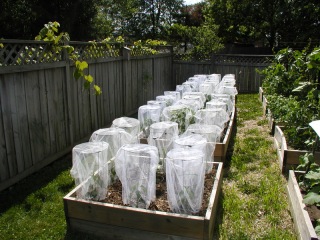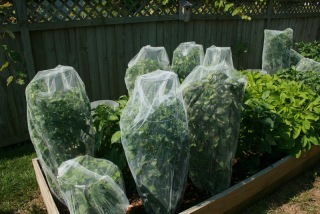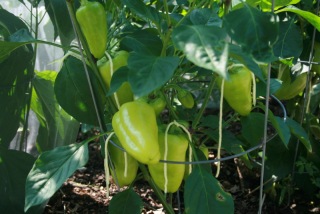Saving seeds from peppers
Seems simple right? Save a few pepper seeds from a pepper and plant them next year. Well, yes and no.
If you only grew one variety and no one else in your neighborhood grew peppers then you can save your seeds without much problem. If however, you are like me and like to plant many different varieties, you will need to plan a little earlier in the season.
Peppers are quite promiscuous. Peppers have “perfect” flowers, meaning that each flower has both male and female parts. If a pepper is left alone, it will simply fertilize itself. But, if you have other varieties near by, bees and other pollinators will make sure that your peppers will have two parents. If you are adventurous then this can be a great thing. Save some seed from peppers in a mixed planting bed and you will likely be surprised next season. You may even be able to tell which plants were responsible for your next generation of peppers. You will certainly know the mother as long as you make note of it when you collect your seed.
Peppers are in the genus Capsicum and there are five major species. If you don’t know what species your pepper is, I would bet my money on annuum. Almost all of the domesticated peppers grown are in the annuum species. Common exceptions are listed below their species.
Capsicum annuum
– most all domestic peppers
Capsicum baccatum
– any of the Aji peppers
Capsicum chinense
– Habaneros
Capsicum frutescens
– Tabasco
Capsicum pubescens
– Rocoto
Here is a general rule, the families will cross between each other albeit limited in many cases. The exception is pubescens, which will not cross with any other species. Sadly, most people in the United States will not have luck growing Rocotos because of the long growing season.
What to do, if you want to grow more than one variety and keep “pure” seed? Isolate your plants, specifically your flowers. You have two options, the first isolating by distance. Peppers are so promiscuous that the recommend distance between varieties is 500 feet. This isn’t possible in my case since my entire yard is only about 125 feet long. The second option is to physically isolate your flowers. For the purpose of illustration, I will give you my history of attempts so that you can see the positives and negatives of several methods.
- The first year, I followed one of the most common methods of using tulle bags to cover individual or clusters of flowers.
Positives: Tulle drawstring bags are fairly cheap and easy to find. Just go to your local crafts store and look in the wedding supplies. You will find several different sizes used for party favors.
Negatives: It is very time consuming. I also had a hard time bagging individual blossoms and when I bagged more than one blossom the blossom branch quickly out grew my bags. I experienced high numbers of blossoms dropping.
Recommendations: If you use this method, go with the larger bags. The bags will allow more room for the branch to grow while blossoms develop and hopefully self fertilize. - The second years, I made cages to cover the entire plant.
Positives: The covers can be made of many materials and the fruit set is quite high.
Negatives: My first attempt, used point bonded row cover material because it was cheap. It also literally dissolved part way through the season. One day, it is there and the next it has an 8 inch whole. It is more expensive than using option one. - The following years, I have used cages to cover the entire plant like year 2. But I used bridal tulle as my material for the covers.
Positives: The nylon tulle seems pretty durable. After 3 seasons, this is the first year I have started to see rips.
Negatives: Tulle varies widely in price. Good old Walmart usually has bolts of tulle for around $20.00. Tulle is a total pain to sew.
My conclusions over the past few years:
Using tomato cages for peppers is ideal. They are horrible at supporting tomatoes but prove almost perfect for peppers. I make bags from bridal tulle which in my case prevents any of my local pollinators from reaching the flowers. The bags are simple pillow cases. Just fold the material back on itself and sew across the top and side leaving the bottom open. To put the bag in place, just slip the open end over the tomato cage and cover the loose bottom edge with soil. A point to note is that the first year I tried to dig a little trench around my peppers and then tried to stuff the loose edge into the trench while using the soil removed to fill the trench. Yeah, don’t do that. It is a pain and doesn’t work. Just take extra soil, or better yet, compost and use this to cover the loose edge. This is not only easier but has the added advantage of providing a berm to hold water when the plants are watered. This past year, I noticed that many of my peppers were just too big for a single tomato cage. My solution was to invert a second cage on top of the first one. I just used zip ties to hold the two cages together. This worked very well with one exception. The isolation bags support the plant a lot more then you might assume. When I took off my bags, I noticed that many of the outside branches were limp noodles because they hadn’t hardened which they normally would in relation to the wind moving the branches back and forth while growing. In my case, I simply tied the branches to the cages.
So what happens when you see peppers inside of your cage? What happens when you pepper out grows your cage? Take it off 🙂 At this point, I will assume that it is still early in the season. What I do, is tie a piece of brightly colored yarn around each pepper that formed while under the isolation cage. This way, you can let your peppers fully mature, before harvesting to save seed.
A couple of notes on actually harvesting the seed. Pepper seed is extremely durable. I use a blender to clean my seed. Just fill your blender with enough water to cover the blades. The add your pepper seeds with any remaining flesh. Blending for a few seconds will separate the flesh or skins from the seeds. Then just fill your blender almost to the top and pour off the water, flesh, seeds etc. at the top of the water. If you repeat this rinsing process several times, you should be left with clean seeds at the bottom. Infertile seeds will float while fertile seeds will sink, so don’t worry about pouring off precious seeds that are floating on the surface. Small peppers can also be blended whole with only the stems removed. A word of warning here, the pepper soup that results is powerful. Keep your face away from the blender when you open it. Even then, expect to cough and sneeze as your rinse your seeds. When you are done cleaning the seeds, pour the water with the seeds into kitchen sieve (make sure the seeds can’t pass through the holes). I then pour the wet seeds onto plastic plates that are labeled to thoroughly dry before storing.
I hope that I have encouraged you to save seed from peppers. Saving seed from peppers has an extra side effect. You can still eat your peppers. Most other vegetables and fruits are destroyed while harvesting seeds.





Very much enjoyed your clear language and sensible procedure – though it dawned on me only at the end that you’re dealing not with sweet peppers but with really hot peppers (and Yes, I’ve learned the hard way about handling those in a blender).
It is very true that I grow a lot of hot peppers, but any of the techniques work equally well for sweet peppers. I have a soft spot for non-bell sweet peppers. A side note on hot peppers and handling. I have for years thought that I had pepper seeds or something slipping inside of my latex gloves that I wore when cleaning my hot peppers. I always ended up with aching hands even with the gloves. Apparently latex gloves are still porous enough for capsaicin to get through. Nitrile gloves solve the problem.
Thanks for the comment and happy gardening.